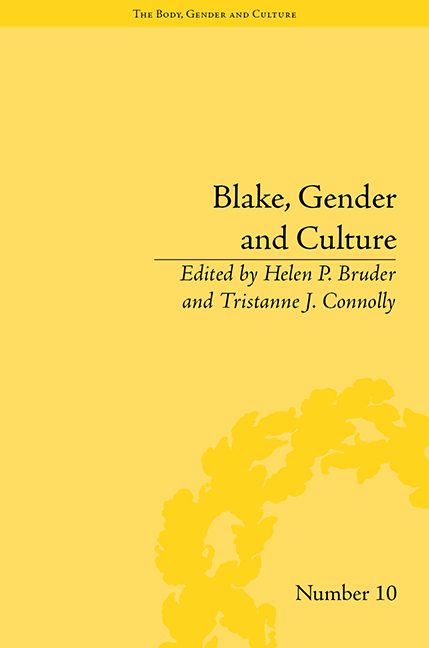Book contents
- Frontmatter
- CONTENTS
- Acknowledgements
- List of Contributors
- List of Figures
- Abbreviations
- Introduction: Naked History Displayed
- 1 ‘Merely a Superior Being’: Blake and the Creations of Eve
- 2 The Last Strumpet: Harlotry and Hermaphroditism in Blake's Rahab
- 3 Sex, Violence and the History of this World: Blake's Illustrations to the Book of Enoch
- 4 Bridal Mysticism and ‘Sifting Time’: The Lost Moravian History of Blake's Family
- 5 ‘A Secret Common to Our Blood’: The Visionary Erotic Heritage of Blake, Thomas Butts and Mary Butts
- 6 Changing the Sexual Garments: The Regeneration of Sexuality in Jerusalem
- 7 Philoprogenitive Blake
- 8 ‘Seeking Flowers to Comfort Her’: Queer Botany in Blake's Visions, Darwin's Loves and Wollstonecraft's Rights of Woman
- 9 ‘Or Wilt Thou Go Ask the Mole?’: (Con)Figuring the Feminine in Blake's Thel
- 10 Gendering the Margins of Gray: Blake, Classical Visual Culture and the Alternative Bodies of Ann Flaxman's Book
- 11 The Virgil Woodcuts Out of Scale: Blake's Gigantic, Masculine Pastoral
- 12 Closet Drama: Gender and Performance in Blake and Joanna Baillie
- Notes
- Works Cited
- Index
10 - Gendering the Margins of Gray: Blake, Classical Visual Culture and the Alternative Bodies of Ann Flaxman's Book
- Frontmatter
- CONTENTS
- Acknowledgements
- List of Contributors
- List of Figures
- Abbreviations
- Introduction: Naked History Displayed
- 1 ‘Merely a Superior Being’: Blake and the Creations of Eve
- 2 The Last Strumpet: Harlotry and Hermaphroditism in Blake's Rahab
- 3 Sex, Violence and the History of this World: Blake's Illustrations to the Book of Enoch
- 4 Bridal Mysticism and ‘Sifting Time’: The Lost Moravian History of Blake's Family
- 5 ‘A Secret Common to Our Blood’: The Visionary Erotic Heritage of Blake, Thomas Butts and Mary Butts
- 6 Changing the Sexual Garments: The Regeneration of Sexuality in Jerusalem
- 7 Philoprogenitive Blake
- 8 ‘Seeking Flowers to Comfort Her’: Queer Botany in Blake's Visions, Darwin's Loves and Wollstonecraft's Rights of Woman
- 9 ‘Or Wilt Thou Go Ask the Mole?’: (Con)Figuring the Feminine in Blake's Thel
- 10 Gendering the Margins of Gray: Blake, Classical Visual Culture and the Alternative Bodies of Ann Flaxman's Book
- 11 The Virgil Woodcuts Out of Scale: Blake's Gigantic, Masculine Pastoral
- 12 Closet Drama: Gender and Performance in Blake and Joanna Baillie
- Notes
- Works Cited
- Index
Summary
Writing to a friend in early 1796, Ann Flaxman praised William Blake's latest endeavour, a set of illustrations for Richard Edwards's edition of Edward Young's Night Thoughts: ‘Edwards has inserted the letter press close cut of Youngs Night Thinto large Margins making a folio size this a friend of ours is ornamenting with most beautiful designs in water colours.’ In a later letter Ann commented that Blake ‘has treated his Poet most Poetically – Flaxman has employ'd him to Illuminate the works of Grey for my Library’. Working on a copy of John Murray's 1790 edition of Gray, Blake adopted the same technique of extra-illustration he had employed on the working copy of Young's Night Thoughts. On the expanded margins of the folio, a naked youth soars out of the book riding a swan upwards ‘through the azure deep of air’ (see Figure 10.1). Tipped onto the illustration slightly off-centre, the book's title page covers part of the swan's wing and the left part of the youth's bottom. This interruption of form conveys dynamism to a flight that seems to originate from within the book and extend beyond the limits of the page. The wider folio margins revoke the title-page's function as the book's boundary. The impression of a continuous deep sky painted in the book's expanded margins blurs the distinction between the world of the poems and the world of the reader.
- Type
- Chapter
- Information
- Blake, Gender and Culture , pp. 133 - 144Publisher: Pickering & ChattoFirst published in: 2014



